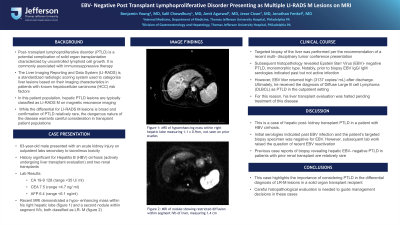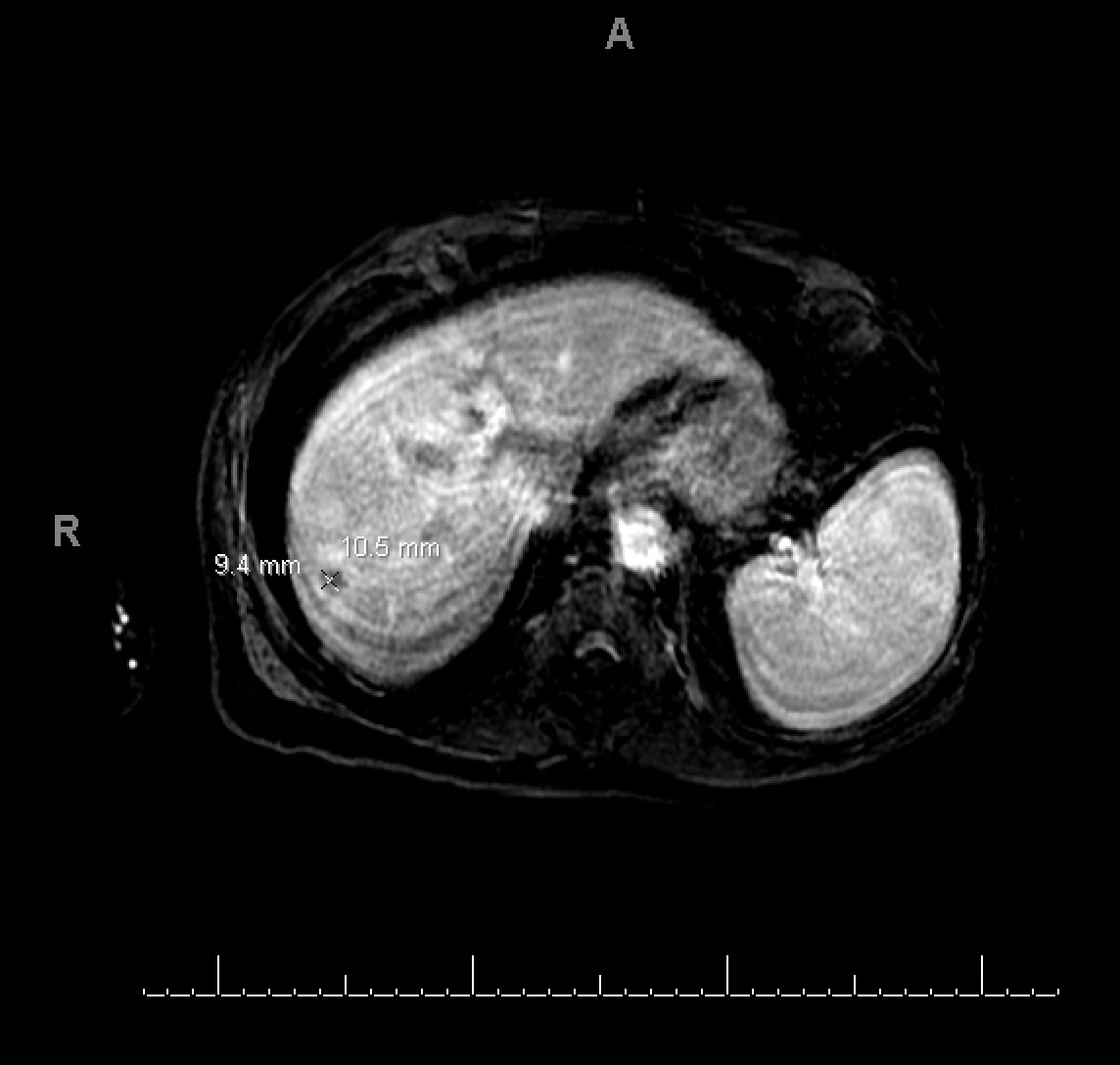Tuesday Poster Session
Category: Liver
P3942 - EBV-Negative Post-Transplant Lymphoproliferative Disorder Presenting as Multiple LI- RADS M Lesions on MRI
Tuesday, October 24, 2023
10:30 AM - 4:00 PM PT
Location: Exhibit Hall

Has Audio

Benjamin Young, MD
Thomas Jefferson University Hospital
Philadelphia, PA
Presenting Author(s)
Benjamin Young, MD1, Salil Chowdhury, MD1, Amit Agrawal, MD2, Jesse Civan, MD1, Jonathan Fenkel, MD1
1Thomas Jefferson University Hospital, Philadelphia, PA; 2Thomas Jefferson University, Philadelphia, PA
Introduction: Post- transplant lymphoproliferative disorder (PTLD) is a potential complication of solid organ transplantation. It is a malignancy characterized by uncontrolled lymphoid cell growth and is commonly associated with immunosuppressive therapy. The Liver Imaging Reporting and Data System (LI-RADS) is a standardized radiologic scoring system used to categorize liver lesions based on their imaging characteristics in patients with known hepatocellular carcinoma (HCC) risk factors. In this patient population, hepatic PTLD lesions are typically classified as LI-RADS M on magnetic resonance imaging (MRI). While the differential for LI-RADS M lesions is broad and confirmation of PTLD relatively rare, the dangerous nature of the disease warrants careful consideration in transplant patient populations.
Case Description/Methods: We describe a case of a 63-year-old male with a history of Hepatitis B (HBV) cirrhosis and two renal transplants who presented with an acute kidney injury on outpatient labs secondary to tacrolimus toxicity. Tumor markers including CA 19-9, CEA, and AFP were elevated on admission. A recent MRI had demonstrated a hypo-enhancing mass within his right hepatic lobe measuring 1.1 x 0.9 cm and a second nodule within segment IVb measuring 1.4 cm, both classified as LR- M. Targeted biopsy was performed per the recommendation of a recent multi- disciplinary tumor conference presentation. Subsequent histopathology revealed Epstein Barr Virus (EBV)- negative PTLD, monomorphic type. Notably, prior to biopsy EBV IgG/ IgM serologies indicated past but not active infection. However, EBV titer came back high (3173) after discharge. Ultimately, he received the diagnosis of Diffuse Large B Cell Lymphoma (DLBCL) as PTLD in the outpatient setting.
Discussion: We describe a case of hepatic post- kidney transplant lymphoproliferative disease in a patient with HBV cirrhosis. Initial serologies indicated past EBV infection and the patient’s targeted biopsy specimen was negative for EBV. However, subsequent lab work raised the question of recent EBV reactivation. Previous case reports of biopsy revealing hepatic EBV- negative PTLD in patients with prior renal transplant are relatively rare. This case highlights the importance of considering PTLD in the differential diagnosis of LIRADS-M lesions in a solid organ transplant recipient. Careful histopathological evaluation is needed to guide management decisions in these cases.

Disclosures:
Benjamin Young, MD1, Salil Chowdhury, MD1, Amit Agrawal, MD2, Jesse Civan, MD1, Jonathan Fenkel, MD1. P3942 - EBV-Negative Post-Transplant Lymphoproliferative Disorder Presenting as Multiple LI- RADS M Lesions on MRI, ACG 2023 Annual Scientific Meeting Abstracts. Vancouver, BC, Canada: American College of Gastroenterology.
1Thomas Jefferson University Hospital, Philadelphia, PA; 2Thomas Jefferson University, Philadelphia, PA
Introduction: Post- transplant lymphoproliferative disorder (PTLD) is a potential complication of solid organ transplantation. It is a malignancy characterized by uncontrolled lymphoid cell growth and is commonly associated with immunosuppressive therapy. The Liver Imaging Reporting and Data System (LI-RADS) is a standardized radiologic scoring system used to categorize liver lesions based on their imaging characteristics in patients with known hepatocellular carcinoma (HCC) risk factors. In this patient population, hepatic PTLD lesions are typically classified as LI-RADS M on magnetic resonance imaging (MRI). While the differential for LI-RADS M lesions is broad and confirmation of PTLD relatively rare, the dangerous nature of the disease warrants careful consideration in transplant patient populations.
Case Description/Methods: We describe a case of a 63-year-old male with a history of Hepatitis B (HBV) cirrhosis and two renal transplants who presented with an acute kidney injury on outpatient labs secondary to tacrolimus toxicity. Tumor markers including CA 19-9, CEA, and AFP were elevated on admission. A recent MRI had demonstrated a hypo-enhancing mass within his right hepatic lobe measuring 1.1 x 0.9 cm and a second nodule within segment IVb measuring 1.4 cm, both classified as LR- M. Targeted biopsy was performed per the recommendation of a recent multi- disciplinary tumor conference presentation. Subsequent histopathology revealed Epstein Barr Virus (EBV)- negative PTLD, monomorphic type. Notably, prior to biopsy EBV IgG/ IgM serologies indicated past but not active infection. However, EBV titer came back high (3173) after discharge. Ultimately, he received the diagnosis of Diffuse Large B Cell Lymphoma (DLBCL) as PTLD in the outpatient setting.
Discussion: We describe a case of hepatic post- kidney transplant lymphoproliferative disease in a patient with HBV cirrhosis. Initial serologies indicated past EBV infection and the patient’s targeted biopsy specimen was negative for EBV. However, subsequent lab work raised the question of recent EBV reactivation. Previous case reports of biopsy revealing hepatic EBV- negative PTLD in patients with prior renal transplant are relatively rare. This case highlights the importance of considering PTLD in the differential diagnosis of LIRADS-M lesions in a solid organ transplant recipient. Careful histopathological evaluation is needed to guide management decisions in these cases.

Figure: Figure 1: A hypo enhancing mass within the right hepatic lobe measures 1.1 x 0.9 cm, not seen on prior study. The mass demonstrates restricted diffusion. Subsequent biopsy revealed Epstein- Barr negative post- transplant lymphoproliferative disorder
Disclosures:
Benjamin Young indicated no relevant financial relationships.
Salil Chowdhury indicated no relevant financial relationships.
Amit Agrawal indicated no relevant financial relationships.
Jesse Civan indicated no relevant financial relationships.
Jonathan Fenkel: Abbvie – Grant/Research Support. Alexion – Consultant. Alexion – Grant/Research Support. Gilead – Grant/Research Support.
Benjamin Young, MD1, Salil Chowdhury, MD1, Amit Agrawal, MD2, Jesse Civan, MD1, Jonathan Fenkel, MD1. P3942 - EBV-Negative Post-Transplant Lymphoproliferative Disorder Presenting as Multiple LI- RADS M Lesions on MRI, ACG 2023 Annual Scientific Meeting Abstracts. Vancouver, BC, Canada: American College of Gastroenterology.
